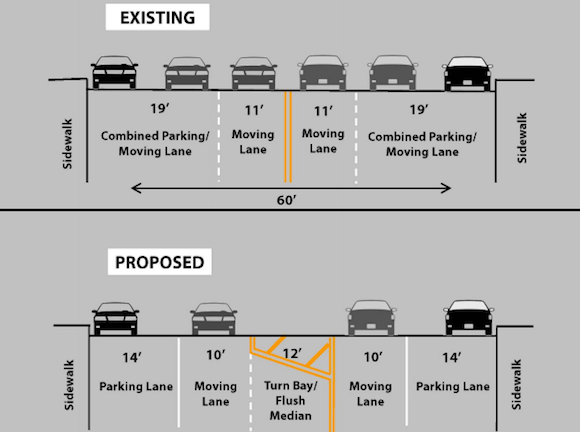 According to Streetsblog.org they say that with Harlem’s Community Board 10, there is apparently no such thing as a street redesign worth pursuing. Over the course of two-and-a-half hours Tuesday night, members of the board’s transportation committee declined to support a road diet for Morningside Avenue, attacked a community-based street safety plan installed on Mount Morris Park West, and asked DOT to reconsider Select Bus Service on 125th Street again – this time on the pretense that it would harm the elderly and disabled.
According to Streetsblog.org they say that with Harlem’s Community Board 10, there is apparently no such thing as a street redesign worth pursuing. Over the course of two-and-a-half hours Tuesday night, members of the board’s transportation committee declined to support a road diet for Morningside Avenue, attacked a community-based street safety plan installed on Mount Morris Park West, and asked DOT to reconsider Select Bus Service on 125th Street again – this time on the pretense that it would harm the elderly and disabled.
The ongoing dysfunction at CB 10 should be a wake-up call to Mayor-elect Bill de Blasio, who has promised at least 20 Bus Rapid Transit routes and set a goal of eliminating traffic fatalities in 10 years. As it currently stands, New York’s community board process is incompatible with those goals, since in effect it enables a small group of people to veto changes to the street, sometimes without any meaningful community involvement. Community boards can be venues for constructive feedback and criticism, but too often they are simply forums to say “no” to change.
Each community board is supposed to represent the interests of people who live in the district — upwards of 100,000 people per board. In the CB 10 district, the vast majority of those people don’t own cars and rely on walking and transit. On Tuesday, there were just four committee members in the room, most of them threatening the cancellation of safety improvements proposed for Morningside Avenue, criticizing other traffic calming projects, and complaining about bus enhancements on 125th Street.
The Morningside Avenue redesign, requested by the North Star Neighborhood Association, has already been vetted at a public forum jointly hosted by Community Boards 9 and 10, which both cover the project area. CB 9 has already passed a resolution in support of the plan. Tuesday night, Karen Horry, acting chair of the CB 10 transportation committee, said she was surprised that CB 9′s resolution [PDF] did not ask DOT to reconsider the road diet, which is the centerpiece of the plan. ”The community has a great deal of concern about the lane reductions, so we were hoping you could address alternatives,” she said to Josh Orzeck, representing DOT’s Manhattan borough commissioner’s office at the meeting.
Horry said she spoke with CB 9 transportation committee chair Carolyn Thompson, who she said is redrafting the resolution to include a section opposing lane reductions and putting it up for a vote again. (Streetsblog’s attempts to contact Thompson have been unsuccessful.)
A number of people testifying before the committee Tuesday night urged DOT to include bike lanes on Morningside Avenue. The plan includes extra-wide parking lanes instead, which provide space for both bike riders and double-parked drivers. ”We’re not averse to putting in bike lanes,” Orzeck said. “The reason it’s not automatically thought about is because it’s not a natural bicycle route.” Later in the meeting, committee member Stephanie Howze said that while she opposed lane reductions, CB 10′s resolution should include a request for bike lanes on Morningside because of the public testimony in support of them.
But there was no vote on a resolution: Because only four committee members were in attendance, there was no quorum. The issue now goes before CB 10′s executive committee, which has the option of putting it on the agenda for the next full board meeting.
Morningside Avenue wasn’t the only traffic calming plan discussed Tuesday night. The committee also requested an update from DOT on complaints about traffic calming on Adam Clayton Powell Jr. Boulevard; the agency said there had been only two 311 complaints about the redesign since August 2012. ”The complaint was that the new markings cause congestion and make it harder to drive,” Orzeck said. “Our data doesn’t prove that out.”
DOT provided an update on street design changes it made at 135th Street and Madison Avenue and along Fifth Avenue from 142nd to 132nd Streets, which have reduced injuries for all road users by 29 percent. The total number of crashes are down 9 percent, and crashes with injuries are down 14 percent. Board members didn’t seem to care much about the improved safety record. ”That data sounds impressive, but as a person that drives down that street every day, I can tell you it’s backed up,” Howze said. “It’s just a lot of confusion.”
Committee members also said that DOT should completely scrap its traffic calming project on Mount Morris Park West. Local residents wanted to slow down speeding drivers racing around park corners; after working with DOT, they agreed on a plan that was supported CB 11′s transportation committee. After the city implemented the changes, other residents pressured DOT into modifying the project by adjusting traffic signals, reducing the size of the pedestrian space, and widening parking and travel lanes. But these adjustments weren’t enough for neighbors who have formed a group dedicated to reversing the changes. Paul and Susan Huck live near Mount Morris Park West and spoke at Tuesday’s meeting. They want the agency to bring back two lanes of traffic, including around turns at 120th and 124th Streets, and install heavy-duty bollards at 120th Street to keep speeding drivers from crashing into homes at the southern end of the park.
CB 10 members also accused the Select Bus Service plan proposed for 125th Street of discriminating against the elderly and disabled, because stops for the M60 would be located on every other block. (Local buses would continue to serve all stops on each block.) “Our concern is that the elderly and disabled are not getting sufficient access,” Horry said. ”It’s mind-boggling why you would reduce the number of stops.”
In addition to off-board fare collection and dedicated bus lanes, limiting the number of stops is a component of Select Bus Service that aims to speed bus trips on 125th Street, which are often slower than walking. Orzeck said he wouldn’t make any promises about DOT making changes in response to the committee. In October, DOT and the MTA announced that the project was on track for implementation next year after being temporarily shelved due to objections from local elected officials and community boards, including CB 10.
Community board members are appointed by borough presidents, and many are nominated for consideration by council members. In Manhattan, the community board application review process has already been launched by Borough President Scott Stringer and will be completed by incoming Borough President Gale Brewer, with terms beginning in April 2014.
For his part, de Blasio has cited ”the need for outreach extending beyond the community board.” That could mean any number of things. Hopefully, it will entail a complete overhaul of the dysfunctional process exemplified by CB 10 Tuesday night.
Join the community board in your area here.
Become a Harlem Insider!
By submitting this form, you are consenting to receive marketing emails from: . You can revoke your consent to receive emails at any time by using the SafeUnsubscribe® link, found at the bottom of every email. Emails are serviced by Constant Contact


















